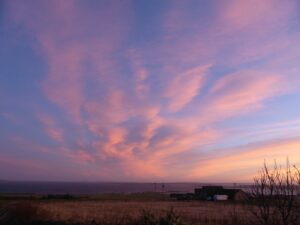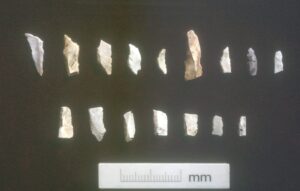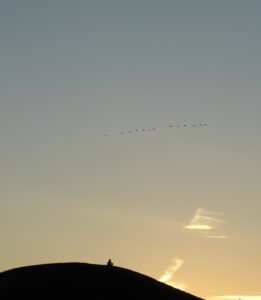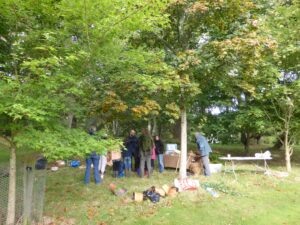
I feel very uncomfortable about accusations of the political use of archaeology. My overwhelming instinct is to stick my head in the sand and avoid discussing or confronting them. I don’t want to stir things up and I don’t want to upset or offend people. But, I’m going to consider it just now because I feel that these are weird times in which we live, and sometimes we must address uncomfortable matters.
Archaeology is inherently political, if nothing else because we are trying to investigate past human communities and people are always, in one way or another, political. But it is one thing to recognise political content and quite another to use that content to make political statements that relate to different (usually modern) times. I don’t like it when people try to bend archaeological interpretation and use it as a window on to present politics. It has been done, and it usually ends in tears.
There has been some discussion in the press and social media about the possible use of the Secrets of Orkney television series to promote a unionist agenda of British politics (see Kenny Brophy’s article as a good starting point). I’m worried by this. Having commented on the representation of Neolithic Britain as a period wherein the expression of some elements of life were shared as material culture across these islands, it has been said that it would have been more representative to celebrate the diversity of Neolithic Britain and the uniqueness of Neolithic Orkney. I wonder if that could be construed as serving the opposite agenda? And are not both views valid?
Surely, as archaeologists we have a duty to present the past in whatever way we each, individually, see it – with the caveat that we need to try to stop our views of the world today from intruding too deeply on our ideas of the world of the past. I realise, of course, that we are all coloured by our beliefs, whether they relate to religion, the current political situation, acceptable foods, the role of music, whatever. But if we allow for a plurality of interpretation then, hopefully, the end result will be ideas that are more balanced across a range of possibilities. We can perhaps even encourage people to critique the archaeological narrative for themselves. It might not be possible to produce an alternative television series for every viewpoint, but it is, surely, possible to make use of other media: books; blogs; newspaper and magazines. It doesn’t do any harm to show the processes of academic debate, and we don’t have to be rude, or confrontational, while we are doing so (let’s save that for in-house conferences and the pub).
I’ve been thinking about this a lot, and I’ve touched on it before, but I don’t believe that there is any correct answer regarding the interpretation of the material that we excavate. As professional archaeologists, we learn to work within academic boundaries, but I can’t tell you what happened in the Mesolithic any more than I can explain the extinction of the dinosaurs. And, as you know, I don’t believe that my word is any more valid than that of the carefully researched artist, TV company, or cartoonist. Does this make me a ‘post-truth’ archaeologist? I fear that it might; though, I’d argue that the application of professionally acceptable boundaries to my thoughts lifts them well above some of the reinterpretations of history that we have seen. It is a slightly different application of the phrase. I’m post-truth in the sense that, while I believe that the facts/data in archaeology are immutable, I also believe that there are different ways to interpret them.
Returning to the Neolithic of Orkney and Britain. The gaps in the evidence are such that it is possible to build narratives that address many different views. I was involved in an advisory capacity with the production of the Secrets series, and so I am, of course, biased. I understood it to be focussed primarily on the Neolithic of Orkney, but, given the lack of popular information relating to the Neolithic, I thought I could understand the need to use Stonehenge as an anchor. The idea that the development of material culture in Orkney pre-dates that further south is hardly new – it has been well covered from the National Geographic Magazine to academic papers. Whether I like it or not, most of the television audience will be more familiar with Stonehenge than Skara Brae. I thought the challenge to contemporary ideas of remoteness worked quite well to get people thinking about a time when the social geography of Britain was not as we know it. For those reasons, the focus on Orkney and Stonehenge did not worry me.
It would, of course, be nice to produce a series that covered the details of Neolithic life in all their glory and diversity, right around the UK. It would be a lengthy series, and it would be expensive, but if someone would like to commission it then do get in touch. We could have fun putting it together. We could, perhaps, ask teams from different places to curate the scene from their locales, so that we are also looking at some of the different viewpoints that affect our ideas of the past. Would we hold our audience? I don’t know and that is why I suspect that us academics are better to leave specialist subjects such as television to the professionals. Nevertheless, we do have a duty to push for increasing public access to our musings, and so I look forward to the material that will, no doubt, be spawned by reaction to the Orkney programmes.
I know that I would be naive not to recognise that archaeology will, on occasion, be used as the handmaiden of politics. There is so much scope that I’m amazed that it does not happen more often. As archaeologists, we are keen to illustrate the ways in which our profession can be of use to the present. But, I’d feel more comfortable if it were possible to be less confrontational. If there is one lesson I’d promote (thereby negating the whole of my argument above), it is that there is, in these north-western islands off the coast of Europe, plenty of room for diversities of view.





You must be logged in to post a comment.